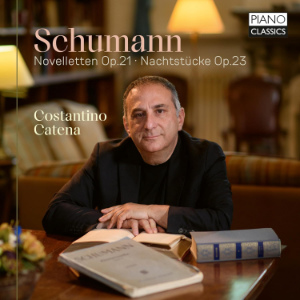
Robert Schumann (1810-1856)
8 Novelletten Op. 21 (1838)
4 Nachstücke Op. 23 (1839)
Costantino Catena (piano)
rec. 2024, Convento di Palazzola, Rocca di Papa, Italy
Piano Classics PCL10305 [70]
These two cycles are among the less popular of Schumann’s piano cycles, but they are both full of interesting music. However, the Novelletten, often excerpted, make a long work when played complete, at around forty-five minutes, and the Nachstücke are generally sombre in mood, so perhaps that accounts for their comparative neglect.
As so often with Schumann, there are literary references in the title and some of the individual pieces of the Novelletten. He described them to a friend as ‘grand, interconnected, adventurous tales.’ He also teased Clara by saying that the title referred to Clara Novello, a soprano, whereas in fact they reflected aspects of his life, including her. They are often unusual in their structure. The first begins with a strong, forthright march-like first theme, with a second section marked Trio, which appears twice. The second piece was suggested by the poem Sarazene und Suleika from Goethe’s Westöstlichen Divan and is a scherzo which Schumann sent to Liszt for comment. It has a middle section marked Intermezzo. The third piece is in quick duple time, like a dance, but again has an Intermezzo, a fast and furious piece, suggested by Macbeth, which Schumann first published on its own. The fourth piece is a waltz though with frequent accents on the offbeats to trap the unwary listener or player. It speeds up towards the end.
The fifth piece is a polonaise, written rather heavily and with lots of chunky chords and a repeating episode. The sixth is capricious, with frequent sudden changes of moods and figuration. The seventh has another forthright main idea but a particularly attractive lyrical middle section. The final piece is much the longest, with numerous episodes and two Trios. At one point a lyrical idea has the comment Stimme aus der Ferne (voice from the distance) above it; this is in fact a theme from one of Clara’s compositions, which Robert incorporated into his piece.
The title of the Nachstücke, night pieces, probably derives from a short story collection with that title by E. T. A. Hoffmann. These were stories which emphasized the supernatural, the unusual and the sinister. They are also associated with the death of Schumann’s brother Eduard. He originally intended to give them titles: Funeral March, Strange Company, Nocturnal Feast and Round with Solo Voices. The first is a sombre march whose second section has an insistent falling motif. The second also features descending figures but is faster and somewhat lighter in mood. The third is a scherzo with two trios. The fourth returns to the mood of the first, but with constant spread chords in the right hand with the solo voices coming in the central episode.
I had not previously come across Costantino Catena, but he has had an active career in Europe for years and has made many recordings, mainly of contemporary music, but also including an earlier recording of Schumann’s Op. 17 Fantasie. I was very taken with his playing. His precise chording, his ability to follow Schumann’s sudden changes of mood and texture, his close observance of Schumann’s dynamics, which often include a sudden drop in tone, and his musical playing of the lyrical passages all impressed me. Although these two cycles are not quite on the level of Schumann’s best, such as Carnaval or Kreisleriana, they are well worth hearing. However, I must mention another recording of this coupling, by Danny Driver, and this also has the Op. 28 Romances. This was well received by Geoffrey Molyneux (review). I have not heard that, but I can say that Catena is an admirable guide to these works. The sound is excellent and the notes, in English only, are helpful.
Stephen Barber
Buying this recording via a link below generates revenue for MWI, which helps the site remain free




















